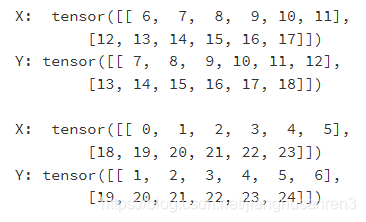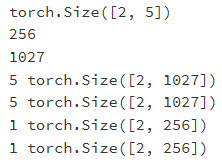第一部分:文本预处理
文本是一类序列数据,一篇文章可以看作是字符或单词的序列,本节将介绍文本数据的常见预处理步骤,预处理通常包括四个步骤:
- 读入文本
- 分词
- 建立字典,将每个词映射到一个唯一的索引(index)
- 将文本从词的序列转换为索引的序列,方便输入模型
#读入文本
import collections
import re
def read_time_machine():
with open('/home/kesci/input/timemachine7163/timemachine.txt', 'r') as f:
lines = [re.sub('[^a-z]+', ' ', line.strip().lower()) for line in f]
return lines
lines = read_time_machine()
print('# sentences %d' % len(lines))
#分词:
def tokenize(sentences, token='word'):
"""Split sentences into word or char tokens"""
if token == 'word':
return [sentence.split(' ') for sentence in sentences]
elif token == 'char':
return [list(sentence) for sentence in sentences]
else:
print('ERROR: unkown token type '+token)
tokens = tokenize(lines)
tokens[0:2]
#建立字典
class Vocab(object):
def __init__(self, tokens, min_freq=0, use_special_tokens=False):
counter = count_corpus(tokens) # :
self.token_freqs = list(counter.items())
self.idx_to_token = []
if use_special_tokens:
# padding, begin of sentence, end of sentence, unknown
self.pad, self.bos, self.eos, self.unk = (0, 1, 2, 3)
self.idx_to_token += ['', '', '', '']
else:
self.unk = 0
self.idx_to_token += ['']
self.idx_to_token += [token for token, freq in self.token_freqs
if freq >= min_freq and token not in self.idx_to_token]
self.token_to_idx = dict()
for idx, token in enumerate(self.idx_to_token):
self.token_to_idx[token] = idx
def __len__(self):
return len(self.idx_to_token)
def __getitem__(self, tokens):
if not isinstance(tokens, (list, tuple)):
return self.token_to_idx.get(tokens, self.unk)
return [self.__getitem__(token) for token in tokens]
def to_tokens(self, indices):
if not isinstance(indices, (list, tuple)):
return self.idx_to_token[indices]
return [self.idx_to_token[index] for index in indices]
def count_corpus(sentences):
tokens = [tk for st in sentences for tk in st]
return collections.Counter(tokens) # 返回一个字典,记录每个词的出现次数
#将词转为索引
for i in range(8, 10):
print('words:', tokens[i])
print('indices:', vocab[tokens[i]])用现有工具进行分词
前面介绍的分词方式非常简单,它至少有以下几个缺点:
标点符号通常可以提供语义信息,但是我们的方法直接将其丢弃了
类似“shouldn’t", “doesn’t"这样的词会被错误地处理
类似"Mr.”, "Dr."这样的词会被错误地处理
我们可以通过引入更复杂的规则来解决这些问题,但是事实上,有一些现有的工具可以很好地进行分词,我们在这里简单介绍其中的两个:spaCy和NLTK。
下面是一个简单的例子:
text = "Mr. Chen doesn't agree with my suggestion."
import spacy
nlp = spacy.load('en_core_web_sm')
doc = nlp(text)
print([token.text for token in doc])
['Mr.', 'Chen', 'does', "n't", 'agree', 'with', 'my', 'suggestion', '.']
from nltk.tokenize import word_tokenize
from nltk import data
data.path.append('/home/kesci/input/nltk_data3784/nltk_data')
print(word_tokenize(text))
['Mr.', 'Chen', 'does', "n't", 'agree', 'with', 'my', 'suggestion', '.']第二部分:语言模型
n元语法
当n分别为1、2和3时,我们将其分别称作一元语法(unigram)、二元语法(bigram)和三元语法(trigram)。例如,长度为4的序列w1,w2,w3,w4在一元语法、二元语法和三元语法中的概率分别为

当n较小时,n元语法往往并不准确。例如,在一元语法中,由三个词组成的句子“你走先”和“你先走”的概率是一样的。然而,当n较大时,n元语法需要计算并存储大量的词频和多词相邻频率。
n元语法可能有哪些缺陷:
- 参数空间过大
- 数据稀疏
# 读取数据集
with open('/home/kesci/input/jaychou_lyrics4703/jaychou_lyrics.txt') as f:
corpus_chars = f.read()
print(len(corpus_chars))
print(corpus_chars[: 40])
corpus_chars = corpus_chars.replace('\n', ' ').replace('\r', ' ')
corpus_chars = corpus_chars[: 10000]
#建立字符索引
idx_to_char = list(set(corpus_chars)) # 去重,得到索引到字符的映射
char_to_idx = {char: i for i, char in enumerate(idx_to_char)} # 字符到索引的映射
vocab_size = len(char_to_idx)
print(vocab_size)
corpus_indices = [char_to_idx[char] for char in corpus_chars] # 将每个字符转化为索引,得到一个索引的序列
sample = corpus_indices[: 20]
print('chars:', ''.join([idx_to_char[idx] for idx in sample]))
print('indices:', sample)
def load_data_jay_lyrics():
with open('/home/kesci/input/jaychou_lyrics4703/jaychou_lyrics.txt') as f:
corpus_chars = f.read()
corpus_chars = corpus_chars.replace('\n', ' ').replace('\r', ' ')
corpus_chars = corpus_chars[0:10000]
idx_to_char = list(set(corpus_chars))
char_to_idx = dict([(char, i) for i, char in enumerate(idx_to_char)])
vocab_size = len(char_to_idx)
corpus_indices = [char_to_idx[char] for char in corpus_chars]
return corpus_indices, char_to_idx, idx_to_char, vocab_size时序数据的采样
在训练中我们需要每次随机读取小批量样本和标签。与之前章节的实验数据不同的是,时序数据的一个样本通常包含连续的字符。假设时间步数为5,样本序列为5个字符,即“想”“要”“有”“直”“升”。该样本的标签序列为这些字符分别在训练集中的下一个字符,即“要”“有”“直”“升”“机”,即X=“想要有直升”,Y=“要有直升机”。
现在我们考虑序列“想要有直升机,想要和你飞到宇宙去”,如果时间步数为5,有以下可能的样本和标签:
X:“想要有直升”,Y:“要有直升机”
X:“要有直升机”,Y:“有直升机,”
X:“有直升机,”,Y:“直升机,想”
…
X:“要和你飞到”,Y:“和你飞到宇”
X:“和你飞到宇”,Y:“你飞到宇宙”
X:“你飞到宇宙”,Y:“飞到宇宙去”
可以看到,如果序列的长度为T,时间步数为n,那么一共有T−n个合法的样本,但是这些样本有大量的重合,我们通常采用更加高效的采样方式。我们有两种方式对时序数据进行采样,分别是随机采样和相邻采样。
随机采样
下面的代码每次从数据里随机采样一个小批量。其中批量大小batch_size是每个小批量的样本数,num_steps是每个样本所包含的时间步数。
在随机采样中,每个样本是原始序列上任意截取的一段序列,相邻的两个随机小批量在原始序列上的位置不一定相毗邻。
import torch
import random
def data_iter_random(corpus_indices, batch_size, num_steps, device=None):
# 减1是因为对于长度为n的序列,X最多只有包含其中的前n - 1个字符
num_examples = (len(corpus_indices) - 1) // num_steps # 下取整,得到不重叠情况下的样本个数
example_indices = [i * num_steps for i in range(num_examples)] # 每个样本的第一个字符在corpus_indices中的下标
random.shuffle(example_indices)
def _data(i):
# 返回从i开始的长为num_steps的序列
return corpus_indices[i: i + num_steps]
if device is None:
device = torch.device('cuda' if torch.cuda.is_available() else 'cpu')
for i in range(0, num_examples, batch_size):
# 每次选出batch_size个随机样本
batch_indices = example_indices[i: i + batch_size] # 当前batch的各个样本的首字符的下标
X = [_data(j) for j in batch_indices]
Y = [_data(j + 1) for j in batch_indices]
yield torch.tensor(X, device=device), torch.tensor(Y, device=device)测试一下这个函数,我们输入从0到29的连续整数作为一个人工序列,设批量大小和时间步数分别为2和6,打印随机采样每次读取的小批量样本的输入X和标签Y。
my_seq = list(range(30))
for X, Y in data_iter_random(my_seq, batch_size=2, num_steps=6):
print('X: ', X, '\nY:', Y, '\n')
相邻采样
在相邻采样中,相邻的两个随机小批量在原始序列上的位置相毗邻。
def data_iter_consecutive(corpus_indices, batch_size, num_steps, device=None):
if device is None:
device = torch.device('cuda' if torch.cuda.is_available() else 'cpu')
corpus_len = len(corpus_indices) // batch_size * batch_size # 保留下来的序列的长度
corpus_indices = corpus_indices[: corpus_len] # 仅保留前corpus_len个字符
indices = torch.tensor(corpus_indices, device=device)
indices = indices.view(batch_size, -1) # resize成(batch_size, )
batch_num = (indices.shape[1] - 1) // num_steps
for i in range(batch_num):
i = i * num_steps
X = indices[:, i: i + num_steps]
Y = indices[:, i + 1: i + num_steps + 1]
yield X, Yfor X, Y in data_iter_consecutive(my_seq, batch_size=2, num_steps=6):
print('X: ', X, '\nY:', Y, '\n')
第三部分:循环神经网络
本节介绍循环神经网络,下图展示了如何基于循环神经网络实现语言模型。我们的目的是基于当前的输入与过去的输入序列,预测序列的下一个字符。循环神经网络引入一个隐藏变量H,用Ht表示H在时间步t的值。Ht的计算基于Xt和Ht−1,可以认为Ht记录了到当前字符为止的序列信息,利用Ht对序列的下一个字符进行预测。


从零开始实现循环神经网络
先尝试从零开始实现一个基于字符级循环神经网络的语言模型,这里使用周杰伦的歌词作为语料,首先我们读入数据:
import torch
import torch.nn as nn
import time
import math
import sys
sys.path.append("/home/kesci/input")
import d2l_jay9460 as d2l
(corpus_indices, char_to_idx, idx_to_char, vocab_size) = d2l.load_data_jay_lyrics()
device = torch.device('cuda' if torch.cuda.is_available() else 'cpu')one-hot向量
def one_hot(x, n_class, dtype=torch.float32):
result = torch.zeros(x.shape[0], n_class, dtype=dtype, device=x.device) # shape: (n, n_class)
result.scatter_(1, x.long().view(-1, 1), 1) # result[i, x[i, 0]] = 1
return result
x = torch.tensor([0, 2])
x_one_hot = one_hot(x, vocab_size)
print(x_one_hot)
print(x_one_hot.shape)
print(x_one_hot.sum(axis=1))我们每次采样的小批量的形状是(批量大小, 时间步数)。下面的函数将这样的小批量变换成数个形状为(批量大小, 词典大小)的矩阵,矩阵个数等于时间步数。也就是说,时间步t的输入为Xt∈Rn×d,其中n为批量大小,d为词向量大小,即one-hot向量长度(词典大小)。
def to_onehot(X, n_class):
return [one_hot(X[:, i], n_class) for i in range(X.shape[1])]
X = torch.arange(10).view(2, 5)
inputs = to_onehot(X, vocab_size)
print(len(inputs), inputs[0].shape)初始化模型参数
num_inputs, num_hiddens, num_outputs = vocab_size, 256, vocab_size
# num_inputs: d
# num_hiddens: h, 隐藏单元的个数是超参数
# num_outputs: q
def get_params():
def _one(shape):
param = torch.zeros(shape, device=device, dtype=torch.float32)
nn.init.normal_(param, 0, 0.01)
return torch.nn.Parameter(param)
# 隐藏层参数
W_xh = _one((num_inputs, num_hiddens))
W_hh = _one((num_hiddens, num_hiddens))
b_h = torch.nn.Parameter(torch.zeros(num_hiddens, device=device))
# 输出层参数
W_hq = _one((num_hiddens, num_outputs))
b_q = torch.nn.Parameter(torch.zeros(num_outputs, device=device))
return (W_xh, W_hh, b_h, W_hq, b_q)定义模型
def rnn(inputs, state, params):
# inputs和outputs皆为num_steps个形状为(batch_size, vocab_size)的矩阵
W_xh, W_hh, b_h, W_hq, b_q = params
H, = state
outputs = []
for X in inputs:
H = torch.tanh(torch.matmul(X, W_xh) + torch.matmul(H, W_hh) + b_h)
Y = torch.matmul(H, W_hq) + b_q
outputs.append(Y)
return outputs, (H,)函数init_rnn_state初始化隐藏变量,这里的返回值是一个元组。
def init_rnn_state(batch_size, num_hiddens, device):
return (torch.zeros((batch_size, num_hiddens), device=device), )做个简单的测试来观察输出结果的个数(时间步数),以及第一个时间步的输出层输出的形状和隐藏状态的形状。
print(X.shape)
print(num_hiddens)
print(vocab_size)
state = init_rnn_state(X.shape[0], num_hiddens, device)
inputs = to_onehot(X.to(device), vocab_size)
params = get_params()
outputs, state_new = rnn(inputs, state, params)
print(len(inputs), inputs[0].shape)
print(len(outputs), outputs[0].shape)
print(len(state), state[0].shape)
print(len(state_new), state_new[0].shape)
裁剪梯度
循环神经网络中较容易出现梯度衰减或梯度爆炸,这会导致网络几乎无法训练。裁剪梯度(clip gradient)是一种应对梯度爆炸的方法。假设我们把所有模型参数的梯度拼接成一个向量 g,并设裁剪的阈值是θ。裁剪后的梯度
def grad_clipping(params, theta, device):
norm = torch.tensor([0.0], device=device)
for param in params:
norm += (param.grad.data ** 2).sum()
norm = norm.sqrt().item()
if norm > theta:
for param in params:
param.grad.data *= (theta / norm)定义预测函数
以下函数基于前缀prefix(含有数个字符的字符串)来预测接下来的num_chars个字符。这个函数稍显复杂,其中我们将循环神经单元rnn设置成了函数参数,这样在后面小节介绍其他循环神经网络时能重复使用这个函数。
def predict_rnn(prefix, num_chars, rnn, params, init_rnn_state,
num_hiddens, vocab_size, device, idx_to_char, char_to_idx):
state = init_rnn_state(1, num_hiddens, device)
output = [char_to_idx[prefix[0]]] # output记录prefix加上预测的num_chars个字符
for t in range(num_chars + len(prefix) - 1):
# 将上一时间步的输出作为当前时间步的输入
X = to_onehot(torch.tensor([[output[-1]]], device=device), vocab_size)
# 计算输出和更新隐藏状态
(Y, state) = rnn(X, state, params)
# 下一个时间步的输入是prefix里的字符或者当前的最佳预测字符
if t < len(prefix) - 1:
output.append(char_to_idx[prefix[t + 1]])
else:
output.append(Y[0].argmax(dim=1).item())
return ''.join([idx_to_char[i] for i in output])我们先测试一下predict_rnn函数。我们将根据前缀“分开”创作长度为10个字符(不考虑前缀长度)的一段歌词。因为模型参数为随机值,所以预测结果也是随机的。
predict_rnn('分开', 10, rnn, params, init_rnn_state, num_hiddens, vocab_size,
device, idx_to_char, char_to_idx)‘分开濡时食提危踢拆田唱母’
困惑度
我们通常使用困惑度(perplexity)来评价语言模型的好坏。回忆一下“softmax回归”一节中交叉熵损失函数的定义。困惑度是对交叉熵损失函数做指数运算后得到的值。特别地,
最佳情况下,模型总是把标签类别的概率预测为1,此时困惑度为1;
最坏情况下,模型总是把标签类别的概率预测为0,此时困惑度为正无穷;
基线情况下,模型总是预测所有类别的概率都相同,此时困惑度为类别个数。
显然,任何一个有效模型的困惑度必须小于类别个数。在本例中,困惑度必须小于词典大小vocab_size。
定义模型训练函数
def train_and_predict_rnn(rnn, get_params, init_rnn_state, num_hiddens,
vocab_size, device, corpus_indices, idx_to_char,
char_to_idx, is_random_iter, num_epochs, num_steps,
lr, clipping_theta, batch_size, pred_period,
pred_len, prefixes):
if is_random_iter:
data_iter_fn = d2l.data_iter_random
else:
data_iter_fn = d2l.data_iter_consecutive
params = get_params()
loss = nn.CrossEntropyLoss()
for epoch in range(num_epochs):
if not is_random_iter: # 如使用相邻采样,在epoch开始时初始化隐藏状态
state = init_rnn_state(batch_size, num_hiddens, device)
l_sum, n, start = 0.0, 0, time.time()
data_iter = data_iter_fn(corpus_indices, batch_size, num_steps, device)
for X, Y in data_iter:
if is_random_iter: # 如使用随机采样,在每个小批量更新前初始化隐藏状态
state = init_rnn_state(batch_size, num_hiddens, device)
else: # 否则需要使用detach函数从计算图分离隐藏状态
for s in state:
s.detach_()
# inputs是num_steps个形状为(batch_size, vocab_size)的矩阵
inputs = to_onehot(X, vocab_size)
# outputs有num_steps个形状为(batch_size, vocab_size)的矩阵
(outputs, state) = rnn(inputs, state, params)
# 拼接之后形状为(num_steps * batch_size, vocab_size)
outputs = torch.cat(outputs, dim=0)
# Y的形状是(batch_size, num_steps),转置后再变成形状为
# (num_steps * batch_size,)的向量,这样跟输出的行一一对应
y = torch.flatten(Y.T)
# 使用交叉熵损失计算平均分类误差
l = loss(outputs, y.long())
# 梯度清0
if params[0].grad is not None:
for param in params:
param.grad.data.zero_()
l.backward()
grad_clipping(params, clipping_theta, device) # 裁剪梯度
d2l.sgd(params, lr, 1) # 因为误差已经取过均值,梯度不用再做平均
l_sum += l.item() * y.shape[0]
n += y.shape[0]
if (epoch + 1) % pred_period == 0:
print('epoch %d, perplexity %f, time %.2f sec' % (
epoch + 1, math.exp(l_sum / n), time.time() - start))
for prefix in prefixes:
print(' -', predict_rnn(prefix, pred_len, rnn, params, init_rnn_state,
num_hiddens, vocab_size, device, idx_to_char, char_to_idx))训练模型并创作歌词
现在我们可以训练模型了。首先,设置模型超参数。我们将根据前缀“分开”和“不分开”分别创作长度为50个字符(不考虑前缀长度)的一段歌词。我们每过50个迭代周期便根据当前训练的模型创作一段歌词。
num_epochs, num_steps, batch_size, lr, clipping_theta = 250, 35, 32, 1e2, 1e-2
pred_period, pred_len, prefixes = 50, 50, ['分开', '不分开']下面采用随机采样训练模型并创作歌词。
train_and_predict_rnn(rnn, get_params, init_rnn_state, num_hiddens,
vocab_size, device, corpus_indices, idx_to_char,
char_to_idx, True, num_epochs, num_steps, lr,
clipping_theta, batch_size, pred_period, pred_len,
prefixes)
循环神经网络的简介实现
定义模型
rnn_layer = nn.RNN(input_size=vocab_size, hidden_size=num_hiddens)
num_steps, batch_size = 35, 2
X = torch.rand(num_steps, batch_size, vocab_size)
state = None
Y, state_new = rnn_layer(X, state)
print(Y.shape, state_new.shape)
torch.Size([35, 2, 256]) torch.Size([1, 2, 256])class RNNModel(nn.Module):
def __init__(self, rnn_layer, vocab_size):
super(RNNModel, self).__init__()
self.rnn = rnn_layer
self.hidden_size = rnn_layer.hidden_size * (2 if rnn_layer.bidirectional else 1)
self.vocab_size = vocab_size
self.dense = nn.Linear(self.hidden_size, vocab_size)
def forward(self, inputs, state):
# inputs.shape: (batch_size, num_steps)
X = to_onehot(inputs, vocab_size)
X = torch.stack(X) # X.shape: (num_steps, batch_size, vocab_size)
hiddens, state = self.rnn(X, state)
hiddens = hiddens.view(-1, hiddens.shape[-1]) # hiddens.shape: (num_steps * batch_size, hidden_size)
output = self.dense(hiddens)
return output, state预测函数
def predict_rnn_pytorch(prefix, num_chars, model, vocab_size, device, idx_to_char,
char_to_idx):
state = None
output = [char_to_idx[prefix[0]]] # output记录prefix加上预测的num_chars个字符
for t in range(num_chars + len(prefix) - 1):
X = torch.tensor([output[-1]], device=device).view(1, 1)
(Y, state) = model(X, state) # 前向计算不需要传入模型参数
if t < len(prefix) - 1:
output.append(char_to_idx[prefix[t + 1]])
else:
output.append(Y.argmax(dim=1).item())
return ''.join([idx_to_char[i] for i in output])使用权重为随机值的模型来预测一次。
model = RNNModel(rnn_layer, vocab_size).to(device)
predict_rnn_pytorch('分开', 10, model, vocab_size, device, idx_to_char, char_to_idx)
'分开胸呵以轮轮轮轮轮轮轮'接下来实现训练函数,这里只使用了相邻采样。
def train_and_predict_rnn_pytorch(model, num_hiddens, vocab_size, device,
corpus_indices, idx_to_char, char_to_idx,
num_epochs, num_steps, lr, clipping_theta,
batch_size, pred_period, pred_len, prefixes):
loss = nn.CrossEntropyLoss()
optimizer = torch.optim.Adam(model.parameters(), lr=lr)
model.to(device)
for epoch in range(num_epochs):
l_sum, n, start = 0.0, 0, time.time()
data_iter = d2l.data_iter_consecutive(corpus_indices, batch_size, num_steps, device) # 相邻采样
state = None
for X, Y in data_iter:
if state is not None:
# 使用detach函数从计算图分离隐藏状态
if isinstance (state, tuple): # LSTM, state:(h, c)
state[0].detach_()
state[1].detach_()
else:
state.detach_()
(output, state) = model(X, state) # output.shape: (num_steps * batch_size, vocab_size)
y = torch.flatten(Y.T)
l = loss(output, y.long())
optimizer.zero_grad()
l.backward()
grad_clipping(model.parameters(), clipping_theta, device)
optimizer.step()
l_sum += l.item() * y.shape[0]
n += y.shape[0]
if (epoch + 1) % pred_period == 0:
print('epoch %d, perplexity %f, time %.2f sec' % (
epoch + 1, math.exp(l_sum / n), time.time() - start))
for prefix in prefixes:
print(' -', predict_rnn_pytorch(
prefix, pred_len, model, vocab_size, device, idx_to_char,
char_to_idx))训练模型。
num_epochs, batch_size, lr, clipping_theta = 250, 32, 1e-3, 1e-2
pred_period, pred_len, prefixes = 50, 50, ['分开', '不分开']
train_and_predict_rnn_pytorch(model, num_hiddens, vocab_size, device,
corpus_indices, idx_to_char, char_to_idx,
num_epochs, num_steps, lr, clipping_theta,
batch_size, pred_period, pred_len, prefixes)
